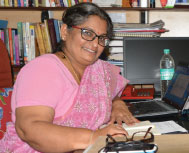Media Education: Demanding yet Challenging
 Technological revolution has brought tremendous change in the overall pattern of life. Competition being the cue word, the success of a company or an individual largely rests on the communication skills while reaching out the target audience. To keep public - both internal and external informed, various channels are utilized by both public and private companies. This change has obviously reflected on the employment opportunities for a media, who traditionally aimed to slip into the shoes of a journalist in a leading newspaper or a television channel.
Technological revolution has brought tremendous change in the overall pattern of life. Competition being the cue word, the success of a company or an individual largely rests on the communication skills while reaching out the target audience. To keep public - both internal and external informed, various channels are utilized by both public and private companies. This change has obviously reflected on the employment opportunities for a media, who traditionally aimed to slip into the shoes of a journalist in a leading newspaper or a television channel.
Globalization, Liberalization and Privatization embed with technological advances in the field of telecommunication changed the entire status of media and the concept of employment related to media. The insurgence of private channels and the competition faced for the survival not only increased competition between the channels but also need for people who can fill the dearth for creative content. Past two decades also saw a tremendous growth in seekers through online. On the third front, a highly competitive corporate world developed, which came with a concept of global marketing. When migrating hired employees became common, keeping them informed and educated about the company was felt essential by the management thus creating space for Corporate Communicators, who handled the internal public largely efficiently.
The expansion in today's social media and the dependency of people on it has completely changed overall perception of people. Be it projection of an individual or a political party or a company, there appears a huge demand for an expert who can not only communicate, but also strategically think before communicating with the outside world. In simple words, we observe that the possibilities, which a media student can explore today have become innumerable and there is an obvious switch over from the role of a journalist for a person with good writing skills to a strategic thinker with a creative mind.
Today, a media graduate can find placement in various positions. They work as business analysts, content developers, web designers, online journalists, advertising, marketing, music managers or RJs in a radio channel, involve themselves in documentary or film production and have many employment options. Education being the prime parameter in the process of recruitment in this age where Industry- academia partnership is predominantly being talked, it is important to know if media education is going on par with the rate of industry growth. Media education, which traces its roots back to 1920s, has seen an implausible demand during last two decades. However, a feeling of penitence bothers when we critically analyze the curriculum content offered particularly by public institutions as a majority of the cross section of the society aspires to make life in media join these institutions. In private institutions too, except those who offer exclusive graduate programs in media, Journalism or Mass Communication or Media Studies bearing different nomenclature offers to teach practical oriented course in a theoretical way. Going by the general rulebook, the gap between academic and industry exists in all fields, but the educational experience that is offered along with the practical world in which people work in media is disturbingly wide.
A majority of faculty members lack practical exposure in the related field as the rigidity of academics in India rarely stresses on the field exposure. The employers particularly in visual media fail to encourage and recognize students with media background who are not competitively trained by their teachers. The provision made for any person, with or without media education background, to enter the field poses a great threat to those aspiring to take media as elective in their higher education.
Structuring a customized education model for visual media education, to empower the students with various specialized and skilled job profiles on creative, technical and management platform in media is the need of the hour. Also, National Skill Development Corporation has identified numerous courses in visual media vertical; the programs have not been initiated yet, as the eligibility criteria to enroll for these courses, the duration and the methodology have not been found convincing.
If the arguments for media education continue to remain focused within the framework of designed curriculum and workload then an opportunity to prepare a communicator to suit the changing needs will be lost. Bringing the professionalism into media education largely rests at the will power of the academicians, thus throwing a huge responsibility on them. This is because a responsible educator will not ignore the developments, but will work alongside their students in understanding their abilities to make them prepared for the rapid development experienced by the industry.
Dr. Nandini Lakshmikantha
She is the Director and Professor at School of Communication, Manipal University, Manipal. Her current responsibilities include teaching, research and administration. She has been a faculty member of Sheshadripuram College, Acharya Institute of Graduate Studies and Manipal University, Bangalore in her experiences. Her expertise includes Status of Media and Current Affairs, Media Laws and Ethics and Marketing Research.

